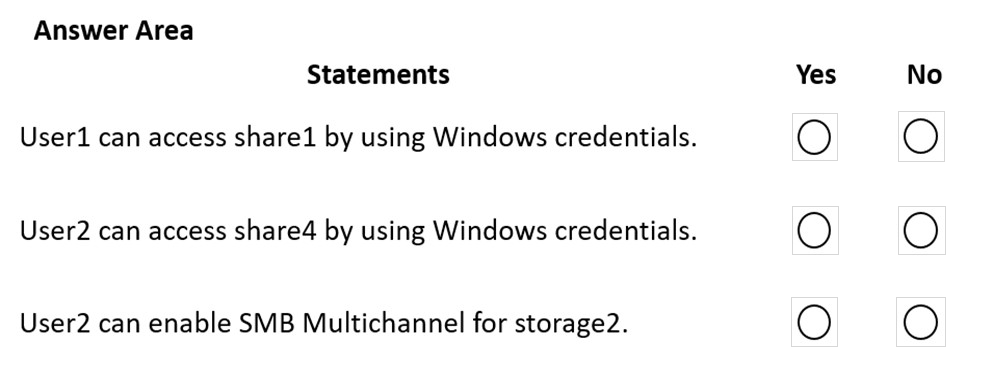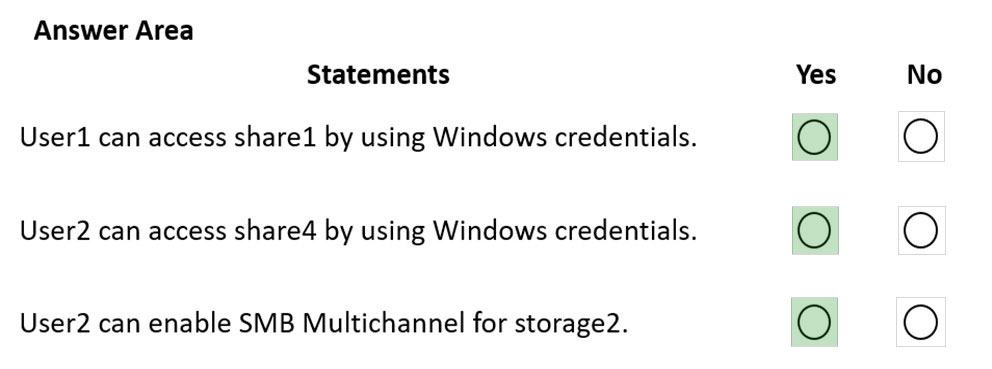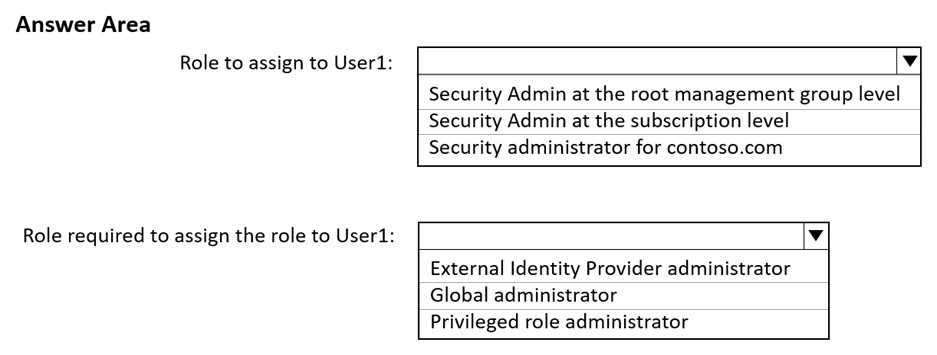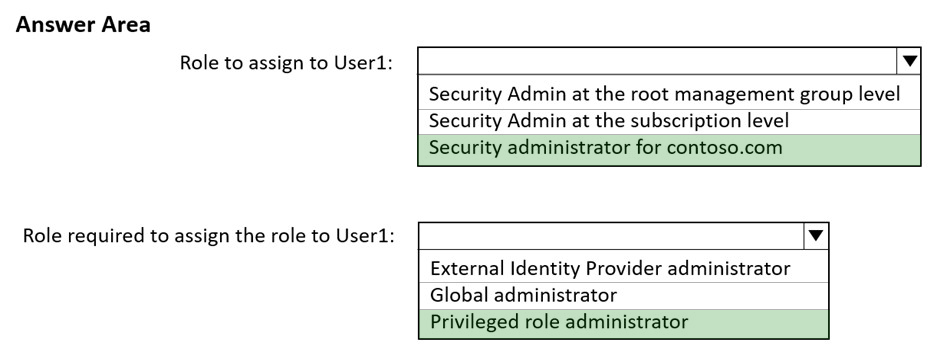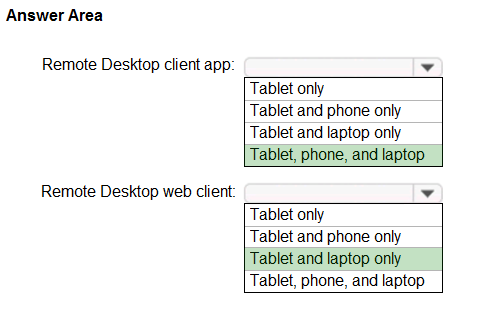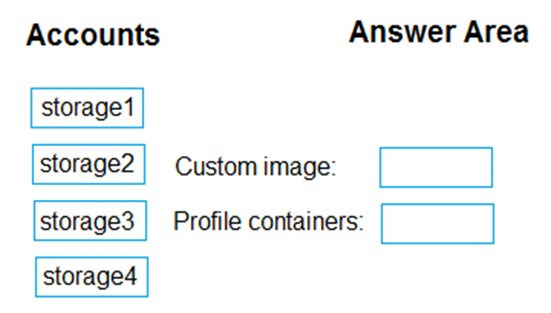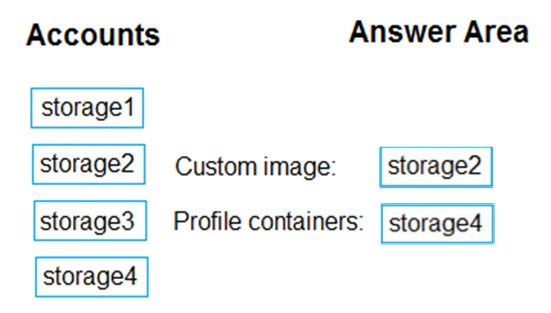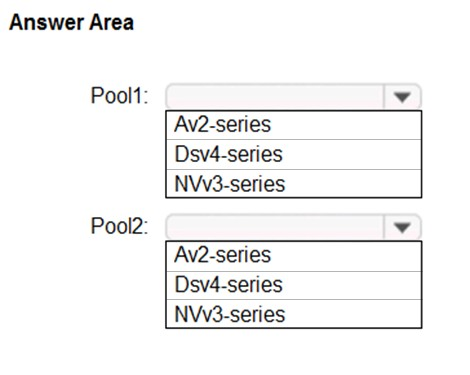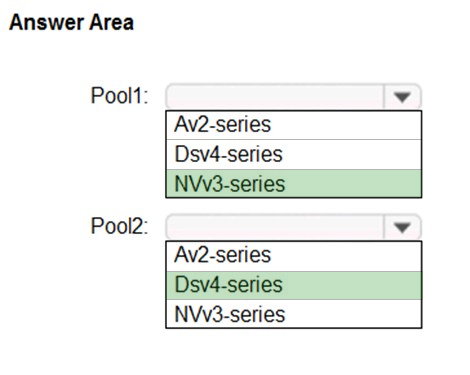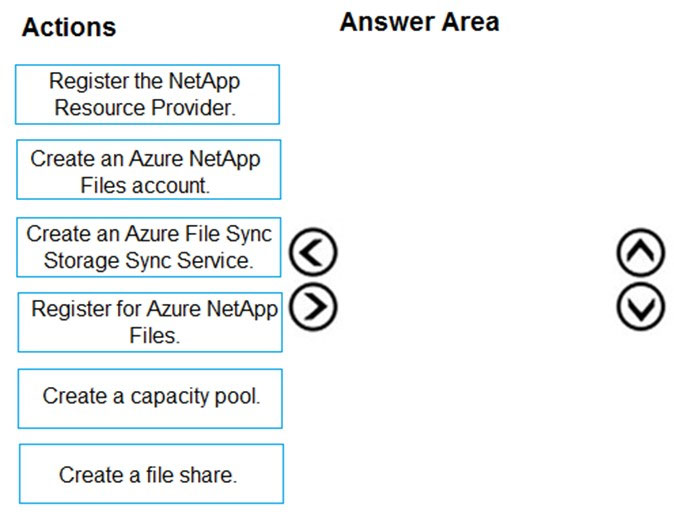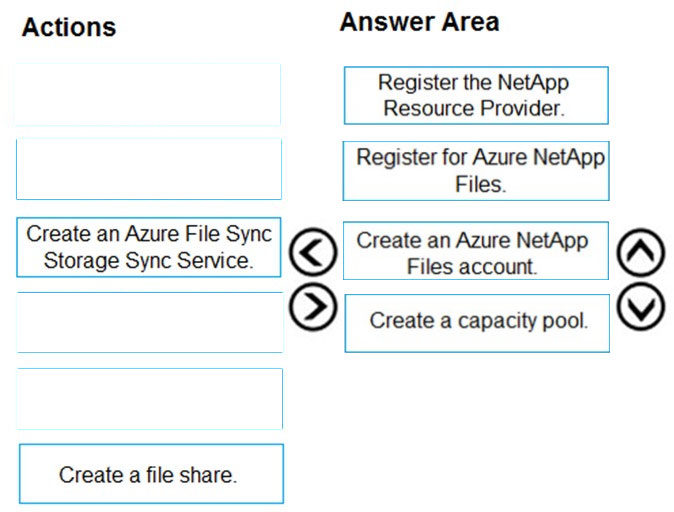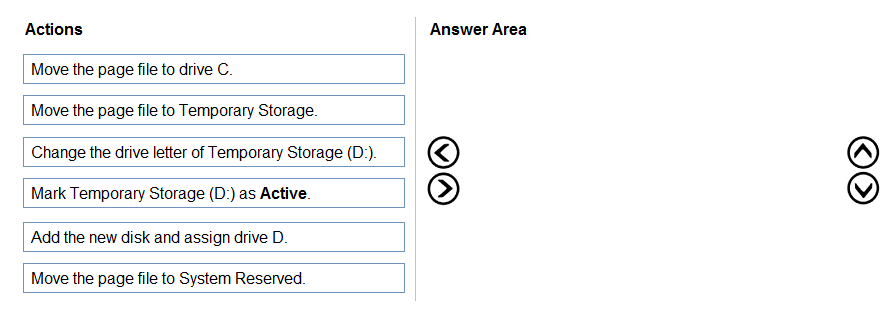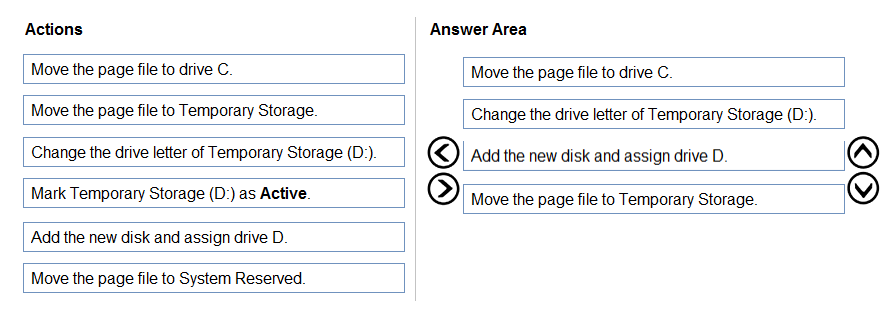AZ-140 Practice Test Free – 50 Real Exam Questions to Boost Your Confidence
Preparing for the AZ-140 exam? Start with our AZ-140 Practice Test Free – a set of 50 high-quality, exam-style questions crafted to help you assess your knowledge and improve your chances of passing on the first try.
Taking a AZ-140 practice test free is one of the smartest ways to:
- Get familiar with the real exam format and question types
- Evaluate your strengths and spot knowledge gaps
- Gain the confidence you need to succeed on exam day
Below, you will find 50 free AZ-140 practice questions to help you prepare for the exam. These questions are designed to reflect the real exam structure and difficulty level. You can click on each Question to explore the details.
You need to recommend an authentication solution that meets the performance requirements. Which two actions should you include in the recommendation? Each correct answer presents part of the solution. NOTE: Each correct selection is worth one point.
A. Configure identity for all the session hosts.
B. In each Azure region that will contain the Azure Virtual Desktop session hosts, create an Azure Active Directory Domain Service (Azure AD DS) managed domain.
C. Deploy domain controllers for the on-premises Active Directory domain on Azure virtual machines to the new sites.
D. Deploy read-only domain controllers (RODCs) on Azure virtual machines to the new sites.
E. In each Azure region that will contain the Azure Virtual Desktop session hosts, create an Active Directory site.
You have an Azure Virtual Desktop deployment that contains multiple host pools. You need to create a PowerShell script to sign users out of a specific session host before you perform a maintenance task. Which PowerShell module should you load in the script?
A. Az.Automation
B. Az.Compute
C. Az.Maintenance
D. Az.DesktopVirtualization
You have an Azure compute gallery that contains the Windows 10 images shown in the following table.You create an Azure Virtual Desktop deployment that has the following settings: • Host pool name: Pool1 • Location: West US • Host pool type: Personal Which images can you use for the session hosts?
A. Image1 only
B. Image2 only
C. Image1 and Image2 only
D. Image1 and Image3 only
E. Image1, Image2, Image3, and Image4
You have an Azure Virtual Desktop deployment. You plan to deploy Update Management to manage automated updates for server-based session hosts. You need to configure the prerequisites for Update Management. Which two actions should you perform? Each correct answer presents part of the solution. NOTE: Each correct selection is worth one point.
A. Create a Log Analytics workspace.
B. Create an Azure Automation account.
C. Create an Azure Service Health alert rule.
D. Enable the Application Insights Agent.
E. Configure Azure Network Watcher.
You have an Azure Virtual Desktop deployment that contains a host pool. The host pool contains 15 session hosts. All the sessions hosts have FSLogix installed. You need to configure the path to where the user profiles are stored. The solution must minimize administrative effort. Which registry setting should you use?
A. VHDLocations
B. CCDLocations
C. ProfileDirSDDL
D. FlipFlopProfileDirectoryName
Your network contains an on-premises Active Directory domain and an Azure Virtual Desktop deployment. The computer accounts for all the session hosts are in an organizational unit (OU) named WVDHostsOU. All user accounts are in an OU named CorpUsers. A domain administrator creates a Group Policy Object (GPO) named Policy1 that only contains user settings. The administrator links Policy1 to WVDHostsOU. You discover that when users sign in to the session hosts, none of the settings from Policy1 are applied. What should you configure to apply GPO settings to the users when they sign in to the session hosts?
A. loopback processing
B. FSLogix profiles
C. mandatory Roaming User Profiles
D. restricted groups
HOTSPOT - You have an Azure Virtual Desktop deployment that contains two users named User1 and User2 and the storage accounts shown in the following table.The File share settings for storage1 are configured as shown in the following exhibit.
The File share settings for storage2 are configured as shown in the following exhibit.
For each of the following statements, select Yes if the statement is true. Otherwise, select No. NOTE: Each correct selection is worth one point. Hot Area:
DRAG DROP - You have an Azure Virtual Desktop deployment. You plan to create the host pools shown in the following table.You need to recommend the virtual machine size for each host pool to meet the session host requirements.
You have an Azure Virtual Desktop deployment. You plan to use FSLogix profile containers. You need to recommend a solution that will be used to store the containers. The solution must meet the following requirements: * The containers must be stored on solid-state drives (SSDs) * Minimize administrative effort * Minimize cost What should you recommend?
A. Azure NetApp Files
B. Azure Files Standard
C. Azure Blob Storage Premium
D. Azure Files Premium
You network contains an on-premises Active Directory domain. The domain contains a universal security group named AVDusers. You have a hybrid Azure Active Directory (Azure AD) tenant. AVDusers syncs to Azure AD. You have an Azure Virtual Desktop host pool that contains four Windows 10 Enterprise multi-session hosts. You need to ensure that only the members of AVDusers can establish Azure Virtual Desktop sessions to the host pool. What should you do?
A. Assign AVDusers to an Azure role scoped to each host pool.
B. On each session host, add AVDusers to the local Remote Desktop Users group.
C. Assign AVDusers to an Azure role scoped to the session hosts.
D. Assign AVDusers to an application group.
HOTSPOT - You have two Azure subscriptions that are linked to an Azure Active Directory (Azure AD) tenant named contoso.com and contain an Azure Virtual Desktop deployment. The tenant contains a user named User1. When User1 signs in to Azure Security Center, the user receives the message shown in the following exhibit.You need to ensure that User1 can manage security information for the tenant. The solution must use the principle of least privilege. What should you do? To answer, select the appropriate options in the answer area. NOTE: Each correct selection is worth one point. Hot Area:
You have an Azure Active Directory (Azure AD) tenant named contoso.com. You use a user account named Admin1 to deploy an Azure Active Directory Domain Services (Azure AD DS) managed domain named aaddscontoso.com to a virtual network named VNET1. You plan to deploy an Azure Virtual Desktop host pool named Pool1 to VNET1. You need to ensure that you can use the Admin1 user account to deploy Windows 10 Enterprise session hosts to Pool1. What should you do first?
A. Add Admin1 to the AAD DC Administrators group of contoso.com.
B. Assign the Cloud device administrator role to Admin1.
C. Assign a Microsoft 365 Enterprise E3 license to Admin1.
D. Change the password of Admin1.
You have the devices shown in the following table.You plan to deploy Azure Virtual Desktop for client access to remove virtualized apps. Which devices support the Remote Desktop client?
A. Device1 and Device2 only
B. Device1 and Device3 only
C. Device1, Device2, and Device3
D. Device1 only
DRAG DROP - You have an Azure Virtual Desktop personal host pool. Each session host in the pool that has an operating system disk and a data disk. You need to back up the session host data disks. Which three actions should you perform in sequence? To answer, move the appropriate actions from the list of actions to the answer area and arrange them in the correct order.
You have an Azure Virtual Desktop host pool named Pool1 that runs Windows 10 Enterprise multi-session hosts. You need to use Performance Monitor to troubleshoot a low frame quality issue that is affecting a current use session to Pool1. What should you run to retrieve the user session ID?
A. Get-ComputerInfo
B. qwinsta
C. whoami
D. Get-LocalUser
You have an Azure Virtual Desktop deployment that uses Microsoft 365 cloud services including Microsoft Teams. Users use the Remote Desktop client to connect to the deployment from computers that run Windows 10. You need to support audio and video in Azure Virtual Desktop and provide the users with access to Microsoft Teams calling and meeting features. Which three actions should you perform? Each correct answer presents part of the solution. NOTE: Each correct selection is worth one point.
A. Install the Microsoft Teams WebSocket Service on the Windows 10 computers
B. Configure the IsWVDEnvironment registry key on the Windows 10 computers
C. Configure the IsWVDEnvironment registry key on the virtual machines
D. Install the Microsoft Teams desktop app on the Windows 10 computers
E. Install the Microsoft Teams WebSocket Service on the virtual machines
F. Install the Microsoft Teams desktop app on the virtual machines
Which role should you assign to Operator2 to meet the technical requirements?
A. Desktop Virtualization Session Host Operator
B. Desktop Virtualization Host Pool Contributor
C. Desktop Virtualization User Session Operator
D. Desktop Virtualization Contributor
Your network contains an on-premises Active Directory domain that syncs to an Azure Active Directory (Azure AD) tenant. The domain contains the domain controllers shown in the following table.The DNS servers are configured to forward requests to an external DNS service. You create a new virtual network named VNET2 that is peered to VNET1 and has gateway transit enabled. You plan to implement an Azure Virtual Desktop host pool in VNET2. The session hosts will be joined to the Active Directory domain. You need to configure DNS to meet the following requirements: ✑ Ensure that Azure Virtual Desktop users can resolve on-premises servers and Azure resources. ✑ Ensure that azure Virtual Desktop remains operational if a DNS server fails. ✑ Minimize administrative effort. What should you configure?
A. the DNS settings of VNET2 to use Server2 and Server1
B. the DNS settings of VNET2 to use the Azure DNS service
C. the DNS settings of the virtual machines to use Server2 and Server1
D. the DNS settings of the virtual machines to use the Azure DNS service
You have an Azure Virtual Desktop host pool in the East US region. You need to implement a disaster recovery solution that meets the following requirements: ✑ If users cannot connect to the Azure Virtual Desktop resources in the East US region, the users must be able to connect to the equivalent resources in the West US region. ✑ Users must connect to the Azure Virtual Desktop resources in either the East US or the West US region by selecting a single icon in the Remote Desktop clientׁ ✑ In the event of a disaster, failover between the Azure regions must be initiated manually by an administrator. ✑ Failover times must be minimized. What should you do?
A. Configure a shared image gallery that has replicas in the East US and West US regions
B. Create new session hosts in the West US region and add the session hosts to an existing host pool
C. Create an additional host pool in the West US region
D. Enable Azure Site Recovery replication of the virtual machines to the West US region
E. Enable Azure Backup to a Recovery Services vault in the West US region
You have an Azure Virtual Desktop deployment that contains a host pool named Pool1. Pool1 contains two session hosts named Host1 and Host2. You need to enable screen capture protection for the deployment. What should you do?
A. Configure a Group Policy setting on Host1 and Host2.
B. From RDP Properties for Pool1, disable Clipboard redirection.
C. Install an Azure virtual machine extension on Host1 and Host2.
D. From RDP Properties for Pool1, disable encoding of redirected video.
You have an Azure Virtual Desktop deployment. You publish a RemoteApp named AppVersion1. You need AppVersion1 to appear in the Remote Desktop client as Sales Contact Application. Which PowerShell cmdlet should you use?
A. New-AzADApplication
B. Update-AzWvdApplicationGroup
C. Register-AzWvdApplicationGroup
D. Update-AzWvdApplication
Your company has a single office and has 40 employees. You are planning an Azure Virtual Desktop deployment. The estimated user workloads are shown in the following table.Half the users of each workload type work from home. All the users who work from home do NOT establish a VPN connection to the office. Approximately how much bandwidth is needed between the office and Azure to support the planned workloads?
A. 9.5 Mbps
B. 55 Mbps
C. 110 Mbps
D. 220 Mbps
You have an Azure Virtual Desktop deployment. You need to monitor the deployment by using the Azure Virtual Desktop Insights solution in Azure Monitor. What should you use as the Diagnostic settings destination for the host pool?
A. Event hub
B. Log Analytics workspace
C. Storage account
HOTSPOT - You have an Azure Virtual Desktop deployment that contains the resources shown in the following table.You need to perform the following configurations: • Enable a managed identity for App1. • Enable Clipboard redirection for App1. On which resources should you perform the configurations? To answer, select the appropriate options in the answer area. NOTE: Each correct selection is worth one point.
You are designing an Azure Virtual Desktop deployment. You identify the network latency between the locations where users reside and the planned deployment. What should you use to identify the best Azure region to deploy the host pool?
A. Azure Traffic Manager
B. Azure Virtual Desktop Experience Estimator
C. Azure Monitor for Azure Virtual Desktop
D. Azure Advisor
You have a hybrid Azure Active Directory (Azure AD) tenant. You plan to deploy an Azure Virtual Desktop personal host pool. The host pool will contain 15 virtual machines that run Windows 10 Enterprise. The virtual machines will be joined to the on-premises Active Directory domain and used by the members of a domain group named Department1. You need to ensure that each user is added automatically to the local Administrators group on the virtual machine to which the user signs in. What should you configure?
A. a role assignment for the host pool
B. a role assignment for each virtual machine
C. a policy preference in a Group Policy Object (GPO)
D. a device setting in Azure AD
You have an Azure Virtual Desktop host pool named Pool1 and an Azure Automation account named Account1. Pool1 is integrated with an Azure Active Directory Domain Services (Azure AD DS) managed domain named contoso.com. You plan to configure scaling for Pool1 by using Azure Automation runbooks. You need to authorize the runbooks to manage the scaling of Pool1. The solution must minimize administrative effort. What should you configure?
A. a managed identity in Azure Active Directory (Azure AD)
B. a group Managed Service Account (gMSA) in Azure AD DS
C. a Connections shared resource in Azure Automation
D. a Run As account in Azure Automation
You have an Azure Virtual Desktop deployment. You use the Start/Stop VMs during off-hours feature in Azure. You need to configure which virtual machines must never be stopped by the solution. What should you configure?
A. the Diagnostic settings of the host pool
B. the Start-Stop-VM task
C. an Azure Automation account variable
D. an action group
HOTSPOT - You have an Azure Virtual Desktop deployment and two Azure Active Directory groups named Group1 and Group2. You create two Conditional Access policies named Policy1 and Policy2. Policy1 is assigned to Group1. Policy2 is assigned to Group2. Both policies include Azure Virtual Desktop as a cloud app. You need to meet the following requirements: • The users in Group1 must be prompted for multi-factor authentication (MFA) when they connect to Azure Virtual Desktop. • The users in Group2 must reauthenticate every eight hours while they are connected to Azure Virtual Desktop. Which settings should you configure in Policy1 and Policy2? To answer, select the appropriate options in the answer area. NOTE: Each correct selection is worth one point.
You have an Azure Virtual Desktop deployment. You plan to create a new host pool named Pool1 that will contain five Windows 11 session hosts. You need to enable secure boot and vTPM on the session hosts. How should you configure the Virtual Machines settings?
A. Enable encryption at rest and a platform-managed key.
B. Set Security type to Trusted launch virtual machines.
C. Enable a system-assigned managed identity.
D. Set Network security group to Advanced.
HOTSPOT - You plan to deploy Azure Virtual Desktop. Users have the devices shown in the following table.From which device types can the users connect to Azure Virtual Desktop resources by using the Remote Desktop client app and the Remote Desktop web client? To answer, select the appropriate options in the answer area. NOTE: Each correct selection is worth one point. Hot Area:
You need to configure the user settings of Admin1 to meet the user profile requirements. What should you do?
A. Modify the membership of the FSLogix ODFC Exclude List group.
B. Modify the membership of the FSLogix Profile Exclude List group.
C. Modify the HKLMSOFTWAREFSLogixProfiles registry settings.
D. Modify the HKLMSOFTWAREFSLogixODFC registry settings.
You have an Azure Virtual Desktop deployment that contains the following: ✑ A host pool named Pool1 ✑ Two session hosts named Host1 and Host2 ✑ An application group named RemoteAppGroup1 that contains a RemoteApp named App1 You need to prevent users from copying and pasting between App1 and their local device. What should you do?
A. Create an AppLocker policy.
B. Modify the locks of RemoteAppGroup1.
C. Assign the Desktop Virtualization Reader role for Pool1 to the users.
D. Modify the RDP Properties of Pool1.
DRAG DROP - You have an Azure subscription that contains the storage accounts shown in the following table.You have a custom generalized Windows 10 image. You plan to deploy an Azure Virtual Desktop host pool that will use the custom image and FSLogix profile containers. You need to recommend which storage accounts to use for the custom image and the profile containers. The solution must meet the following requirements: Minimize costs to store the image.
✑ Maximize performance of the profile containers. Which account should you recommend for each type of content? To answer, drag the appropriate accounts to the correct content type. Each account may be used once, more than once, or not at all. You many need to drag the split bar between panes or scroll to view content. NOTE: Each correct selection is worth one point. Select and Place:
You have an Azure Virtual Desktop personal host pool named Pool1 that contains 20 Azure AD-joined session hosts. You need to ensure that only approved virtual machine extensions are installed on the Pool 1 session hosts. The solution must minimize administrative effort. What should you use?
A. Azure Resource Manager (ARM) templates
B. Azure Policy
C. Windows Admin Center
D. Group Policy
Which two roles should you assign to Admin2 to meet the security requirements? Each correct answer presents part of the solution. NOTE: Each correct selection is worth one point.
A. Desktop Virtualization Host Pool Contributor
B. Desktop Virtualization Application Group Contributor
C. Desktop Virtualization Workspace Contributor
D. Desktop Virtualization Application Group Reader
E. User Access Administrator
You have an Azure Virtual Desktop deployment. You need to create a host pool. The solution must ensure that during periods of low CPU usage, credits can be accumulated, and then used to raise performance above the purchased baseline during periods of high CPU usage. Which virtual machine series should you specify when you create the pool?
A. A-series
B. D-series
C. H-series
D. B-series
You have an Azure storage account that contains the generalized Windows 10 disk images shown in the following table.You need to create an image that will be used to deploy an Azure Virtual Desktop session host. Which disk should you use?
A. Disk1
B. Disk2
C. Disk3
D. Disk4
After you answer a question in this section, you will NOT be able to return to it. As a result, these questions will not appear in the review screen. You have an Azure Virtual Desktop host pool named Pool1 that is integrated with an Azure Active Directory Domain Services (Azure AD DS) managed domain. You need to configure idle session timeout settings for users that connect to the session hosts in Pool1. Solution: From the Azure portal, you modify the Advanced settings in the RDP Properties of Pool1. Does this meet the goal?
A. Yes
B. No
You plan to implement the FSLogix profile containers for the Seattle office. Which storage account should you use?
A. storage2
B. storage4
C. storage3
D. storage1
HOTSPOT - You have an Azure Virtual Desktop deployment. You plan to create the host pools shown in the following table.You need to recommend the virtual machine size for each host pool. The solution must minimize costs. Which size should you recommend for each pool? To answer, select the appropriate options in the answer area. NOTE: Each correct selection is worth one point. Hot Area:
DRAG DROP - You have an Azure Virtual Desktop host pool named Pool1. You need to ensure that you can create an Azure NetApp Files volume that will host user profiles for Pool1. Which four actions should you perform in sequence? To answer, move the appropriate actions from the list of actions to the answer area and arrange them in the correct order. NOTE: More than one order of answer choices is correct. You will receive credit for any of the correct orders you select. Select and Place:
HOTSPOT - You have an Azure Virtual Desktop deployment that contains two Azure AD-joined session hosts named Host1 and Host2. FSLogix Profile Containers and Office Containers have different locations and are used for both session hosts. You have an Azure AD tenant that contains the users shown in the following table.Host1 contains the local groups shown in the following table.
Host2 contains the local groups shown in the following table.
For each of the following statements, select Yes if the statement is true. Otherwise, select No. NOTE: Each correct selection is worth one point.
You need to ensure the resiliency of the user profiles for the Boston office users. The solution must meet the user performance requirements. What should you do?
A. Modify the Account kind setting of storage1.
B. Modify the replication settings of storage1.
C. Implement Azure Site Recovery.
D. Configure Cloud Cache.
HOTSPOT - You have an Azure Virtual Desktop deployment that contains the session hosts shown in the following table.You have the users shows in the following table.
Users connect to Azure from the locations shown in the following table.
For each of the following statements, select Yes if the statement is true. Otherwise, select No. NOTE: Each correct selection is worth one point.
You plan to deploy Azure Virtual Desktop. The deployment will use existing virtual machines. You create a Azure Virtual Desktop host pool. You need to ensure that you can add the virtual machines to the host pool. What should you do first?
A. Register the Microsoft.DesktopVirtualization provider.
B. Generate a registration key.
C. Run the Invoke-AzVMRunCommand cmdlet.
D. Create a role assignment.
You have an Azure AD tenant that contains a resource group named RG1. RG1 contains the resources shown in the following table.Your on-premises network has an IP address range of 192.168.10.0/24. Users on Host1 can successfully connect to the resources on the network. You add a new on-premises network that has an IP address range of 192.168.11.0/24 and contains a subnet. The subnet contains an application server named App1. Users report that Host1 cannot connect to App1. You need to ensure that the users on Host1 can access App1. What should you modify?
A. the Connections settings of VPNGW1
B. the Subnets setting of VNet1
C. the Configuration settings of LNGW1
D. the DNS server settings of VNet1
E. the RDP Properties of the host pool
You have an Azure subscription named Subscription that contains an Azure Virtual Desktop host pool named HostPool1. HostPool1 is managed by using Microsoft Intune. Subscription1 contains 50 users that connect to HostPool1 by using computers that run Windows 10. You need to prevent the users from copying files between an Azure Virtual Desktop session and the computers. The solution must minimize administrative effort. What should you do?
A. Modify the RDP properties of HostPool1.
B. Create a Conditional Access policy in Azure Active Directory (Azure AD).
C. Create a compliance policy in Intune.
D. Create a configuration profile in Intune.
DRAG DROP - You have a Azure Virtual Desktop deployment. You have a session host named Host1 that has the disk layout shown in the exhibit. (Click the Exhibit tab.)You plan to deploy an app that must be installed on D. The app requires 500 GB of disk space. You need to add a new data disk that will be assigned the drive letter D. The solution must maintain the current performance of Host1. Which four actions should you perform in sequence? To answer, move the appropriate actions from the list of actions to the answer area and arrange them in the correct order. Select and Place:
You have an Azure Virtual Desktop deployment. In Azure Advisor, you discover the following recommendation related to Azure Virtual Desktop: ✑ Impact: Medium ✑ Description: No validation environment enabled ✑ Potential Benefit: Ensure business continuity through AVD service deployments ✑ Impacted Resource: 1 Host Pool What can you validate by implementing the recommendations?
A. Security settings of Azure Virtual Desktop
B. Capacity requirements of session hosts
C. Azure Site Recovery failover of the session hosts
D. Preview features for Azure Virtual Desktop
Free Access Full AZ-140 Practice Test Free Questions
If you’re looking for more AZ-140 practice test free questions, click here to access the full AZ-140 practice test.
We regularly update this page with new practice questions, so be sure to check back frequently.
Good luck with your AZ-140 certification journey!


